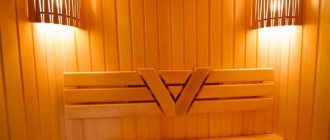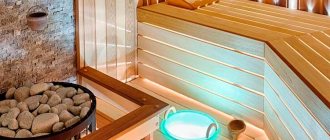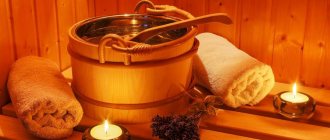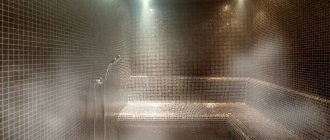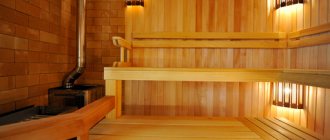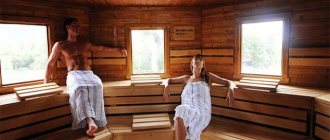Since ancient times, bath procedures have been considered a panacea for many ailments. Doctors actively recommend that patients visit a steam bath to improve their health and strengthen their body. In addition, historically, the bathhouse was a sacred place where children were given birth and baptized, met with friends and had intimate conversations. It is still customary to carry out Christmas rituals in Russian bathhouses.
In modern life, the Finnish sauna competes with the Russian bath. What is the difference between these bath procedures? Why does someone prefer wet or dry steam, how does the body react to a sauna and steam bath? And what's better?
The harm and benefits of a sauna for the body
Bath procedures undoubtedly have a beneficial effect on the human body, and many experts recommend such procedures to maintain health and prolong youth. However, temperature changes are, in a sense, stress for the human body. And they can also cause harm.
How is it useful?
Positively affects the following human organs and systems:
- Skin - cleanses dirt and microorganisms, removes dead skin particles and promotes rejuvenation, helps get rid of acne and prevent their appearance, improves thermoregulation, helps smooth out wrinkles and makes the skin softer.
- Cardiovascular system – helps normalize work, improves blood circulation, stimulates the heart muscle.
- Nervous system - helps cope with stress, reduces tension, helps enrich the brain with oxygen, reduces excitability, normalizes sleep.
- Respiratory organs – promotes the removal of stagnant mucus, improves lung function.
- Musculoskeletal system - relaxes muscles and relieves fatigue, improves the elasticity of ligaments, improves nutrition and reduces swelling of the joints, promotes healing after injuries and accelerates the restoration of bone tissue.
Harm from visiting a sauna
Considering the large number of useful properties, we should not forget that this procedure is associated with overheating and temperature changes. And this, in certain cases, can negatively affect health. After all, constant and excessive overheating leads to problems such as dehydration, blood thickening, increased blood pressure, increased heart rate, weakness and even loss of consciousness.
In addition, it is necessary to take into account cases in which sauna procedures are generally contraindicated:
- for hypertension;
- for heart diseases;
- for chronic inflammation of the abdominal cavity;
- in the presence of various neoplasms and oncology;
- for some mental illnesses;
- in the postoperative period;
- with cholelithiasis with attacks;
- in the presence of infectious diseases;
- in the presence of purulent and bleeding wounds on the skin;
- with chronic hepatitis.
Women should refrain from visiting during pregnancy and lactation. And men need to observe moderation in the frequency and duration of thermal procedures, since their abuse can negatively affect the reproductive function of the body. Children are allowed to visit the sauna no earlier than three years of age after consultation with a pediatrician and only on the lower shelves.
- 6 months ago
#bath#sauna#sauna#key#sauna#key#bathhouse construction#sauna construction
- 6 months ago
- 6 months ago
#bath#sauna#sauna#key#sauna#key#bathhouse construction#sauna construction
- 6 months ago
#bath#sauna#sauna#key#sauna#key#bathhouse construction#sauna construction
- 6 months ago
#bath#sauna#sauna#key#sauna#key#bathhouse construction#sauna construction
- Enter the parameters of your sauna or simply leave a request
- We will receive an estimate for your project from each of our contractors
- We will choose the best offer and contact you
- You will get a sauna at the best price
Your promo code: “Sauna for you”! Tell it to our employee and the surveyor’s visit will be free for you.
What it is?
Historically, a Finnish sauna is a low, enclosed, small space from 2 to 6–8 square meters. m, designed for 2–3 people. Previously, such baths were heated by a hearth placed in the center of the room with hot stones. There was no chimney as such; ventilation was carried out through an open door and an inlet near the floor. The room was very dry and hot.
Instead of a washing room, there was a barrel with cold water or there was a natural pond nearby.
Modern technologies have made it possible to get rid of suffocating smoke and soot using ventilation systems and new modifications of stoves with chimneys. A barrel of water has been replaced by a font, pool or shower. The absence of windows is compensated for by electric lighting.
Humidity - the difference between a Russian bath and a Finnish sauna
A feature of the Finnish sauna is the characteristic dryness of the air; its humidity does not exceed 20%. Such dryness and low heat capacity allows you to heat the steam room to one hundred degrees or more. This, of course, affects people's health. For example, if you have certain health problems, then you should be very careful when visiting the sauna. If only because dry air negatively affects our mucous membranes and can provoke a cough.
In a Finnish sauna, the body is constantly exposed to severe stress, since the steam is very dry and the air does not mix.
But a Russian bath has higher humidity than a sauna. To remove toxins and waste from your body, you need to warm up thoroughly, and for such a procedure to be as safe as possible for the body, the conditions must be close to natural. Therefore, the air humidity in the bathhouse is approximately 70%, and its temperature fluctuates around 50 degrees, occasionally rising to a maximum of 80.
Conditions in a Russian bathhouse are more favorable for people with health problems or bathhouse newcomers:
- conditions in a Russian bathhouse are close to natural;
- air with high humidity has good thermal conductivity and promotes deep heating;
- with the help of a broom, the healing properties of the Russian bath are improved, it replaces the massage procedure;
- The bathhouse does not cause spasms and accelerated heartbeat, unlike the sauna, it can be visited by people with heart problems.
The sauna also features light steam, but to get it, you need to pour water on the stones. The steam will disperse into small particles, which will give the feeling of hot air, which, unlike steam in a sauna, will not have a burning effect.
When you enter the sauna, the stones are not very hot, so they need to be heated in the oven. Stove walls should have minimal heat transfer; it will be good if only the stones are heated, and not the stove itself. In order not to place the entire stove in the steam room, it is better to place it in the dressing room.
Often, due to their inexperience, many people create raw steam; it is very thick, but with such steam there is a risk of suffocation. To make staying in a Russian bath comfortable, the temperature of the air and the stones must be different. Also, when the air is scorched, the broom tends to dry out and its use will not bring the expected effect.
The main attributes of the Finnish sauna and Russian bath: is there a need for them?
Many people know that a bathhouse may differ from a sauna in terms of attributes, such as:
- location of stones;
- pool;
- broom and more.
Now let's move on to the description of the attributes and find out whether the attributes characteristic of a Finnish sauna can be used in a Russian bath and vice versa.
In a sauna, stones are placed in an open space so that they give off their heat, but the difference between the location of stones in a bathhouse is that they are in a closed oven and can be stored longer. The door is opened only to pour water over the stones to increase the steam.
A swimming pool is an attribute characteristic of a sauna; it is installed because a quick change from hot steam to cold water has a positive effect on health. Also, some of the saunas are equipped with massage tables so that a person can relax as much as possible. A swimming pool is not typical for a Russian steam room, since historically bathhouses were always built next to bodies of water, and after taking a bath, people went to swim in a river or lake even in winter. However, now baths can also be equipped with a swimming pool or a wooden plunge pool.
One of the important attributes of a Russian bath is a broom made from birch or oak or other trees. Before use, soak the broom in hot water. It is believed that blows from brooms are much better than massages in increasing blood circulation, opening pores and increasing sweat production.
By the way, the force of a blow with a broom does not in any way affect the enhancement of the positive effect, so it is not necessary to hit it with all your might; it is much more important to inhale the aromas of the tree, which charge us with vigor and relieve us of negative emotions.
But you can’t use a broom in a Finnish sauna, because it simply won’t give the desired effect, because under the influence of low humidity the leaves will instantly dry out and fall off.
Some visiting traditions
Traditions of the Russian bath
A broom is the main attribute. Different brooms have different effects. On the one hand, massage, on the other, the aroma released from steamed leaves under the influence of temperature.
You can move in the steam room. After leaving the steam room, you need to sit in the dressing room. Relax. About the pool. Previously, baths were built near reservoirs, but now swimming pools are built in.
Finnish sauna traditions
Here, a broom is not held in high esteem, but the use of various essential oils is encouraged. They are diluted with water and sprayed on the walls. In the sauna, the best thing to do is lie down. Quiet, calm and relaxed. After leaving, the best solution for a healthy person is to take a short dip in a pool of cool water.
The benefits of the Turkish steam room
Hammam and sauna differ in the amount of wet vapor. While Finnish steam rooms are filled with dry air, Turkish baths maintain a humid microclimate. Due to the bath conditions, sweating is minimal, and the body gets wet due to the formation of condensation. The skin and hair do not dry out, so the hammam is a good alternative to the steam room for people suffering from allergies and increased sensitivity of the body. Despite the slight heating of the room, under the influence of moisture the pores expand faster.
It is advisable to arrange steam sessions in Turkish steam rooms:
- For people who prefer to accompany steam treatments with aromatherapy. The hammam provides the opportunity to visit the solarium.
- In order to strengthen the functioning of the heart and blood vessels.
- For complete warming up of muscles and joints.
- In order to relieve stress, conduct relaxation sessions.
- To combat the symptoms of bronchitis and runny nose at an early stage.
- For girls who want to thoroughly cleanse their skin pores of dirt.
- In order to normalize metabolism and rejuvenate the body. Weight loss occurs faster if you combine training and a balanced diet with a visit to the hammam.
Essential oils for aromatherapy
What it is?
The first Finnish saunas were built from pits covered with animal skins. Then smoke steam rooms appeared, followed by wood-burning and electric steam rooms. For centuries, the sauna was a separate building. When a Finnish family started building a house, they always started with a sauna. The whole family lived there until the big house was completed.
For the Finns, such a building is made exclusively of wood. There are convenient shelves along the walls where you need to lie down for a while. To create a unique atmosphere and aroma, herbs are hung inside. The smell of natural wood and plants is unique.
According to the technology, the temperature inside should be up to 120 C, but rarely drops below 100 degrees. In Finland, the humidity inside the sauna should be at the normal level, that is, no more than 15%.
When the body heats up, the process of intense sweating begins. With such humidity, sweat evaporates, so the body does not overheat. Afterwards, you are advised to dive into a pool of cold water or douse yourself with it. In this case, a comfortable temperature for the body is considered to be from 32 to 40 C. After such procedures, your mood rises, your general health improves, and you feel a surge of strength.
Impact on the human body
To understand what is better for your health - a bathhouse or a sauna, you should know how steam affects the body. Any steam room has a positive effect on health, strengthening the immune system, cleansing the skin of pollution, removing toxic toxins and waste. Under the influence of high temperatures, the vessels fill with blood.
A visit to the steam room helps:
- relaxation of muscle tissue;
- the appearance of a feeling of peace, tranquility;
- improving well-being;
- strengthening the immune system.
Attention! People with diseases of the cardiovascular system should visit the bathhouse if the conditions in the steam room are identical to the natural environment. The load on the heart with significant heating of the room increases several times. Doctors advise patients with respiratory diseases to regularly visit traditional Russian baths
Humid air helps cleanse the respiratory organs, fill them with oxygen, and activate the lungs. After one session the patient feels relief. It is not advisable to go to the sauna. Dry vapors can lead to exacerbation of the disease
Doctors advise patients with respiratory diseases to regularly visit traditional Russian baths. Humid air helps cleanse the respiratory organs, fill them with oxygen, and activate the lungs. After one session the patient feels relief. It is not advisable to go to the sauna. Dry vapors can lead to exacerbation of the disease.
It is advisable to visit Finnish steam rooms for patients who have:
- stones in the kidneys;
- skin pathologies;
- inflammatory processes in the organs of the urinary system, liver.
Both steam rooms are good for preventing the development of ARVI and influenza. The main condition is regular attendance. One session is not enough to strengthen the immune system.
People suffering from hypertension, diabetes, atherosclerosis, severe forms of mental disorders, acute diseases of the upper respiratory tract should forget about the sauna and steam bath.
Similarities
The sauna from Finland and the bathhouse from Russia are useful places that provide pleasant steam treatments. Moist or dry air contributes to:
- Complete relaxation of the body. Muscles are relieved of tension.
- Relief from fatigue and stress. Good spirits and vitality return.
- Steaming the skin. The pores open, allowing toxins and impurities to come out.
- Accelerates blood microcirculation. The replenishment of organs and individual parts of the body is more intense.
- Removing excess fluid from the body. Steam rooms are recommended for girls who want to lose weight.
- Skin rejuvenation. The epithelium tightens, becomes more elastic, elastic. After several regular sessions, the “orange peel” appearance decreases.
- Hardening the body.
- Strengthening the immune system.
Steam rooms from Finland and Russia cannot be equated. There are certainly many similarities between them, but there are also plenty of differences. Where to go to relax, everyone must decide for themselves. It is important that visiting the steam room is a pleasure, not a discomfort.
Tags: bathhouse, what, Russian, Finnish, good
« Previous entry
The difference between a bathhouse and a sauna
So what's the difference? Let's start with the sauna. The first component of the sauna is high temperature, reaching up to +140 degrees. But at the same time, the air in such a steam room is dry and has about 10-15% humidity. In a sauna, a person tends to have less motor movements, since the air is scaldingly dry.
The operating principles of our saunas are not complicated, the fire in the stove heats the stones very much, and they naturally accumulate heat and then release it to the environment.
A sauna can be useful for almost everyone, regardless of age, under one condition: you must be able to use it correctly. By visiting a sauna, you can activate blood flow, train (provided there are no chronic diseases) the cardiovascular system, but at the same time the pressure remains normal. Due to the organic activation of metabolism, excess fats are burned and “unnecessary” cholesterol is eliminated.
The bathhouse is characterized by temperatures up to +80 degrees Celsius and air humidity up to 60%. In the bath, due to steam, high humidity is determined.
When the sauna is ready and warmed up, you need to add water to the stones to create steam. What is characteristic of a bathhouse is that a person’s movements do not bring him discomfort and do not burn his body. The main advantage of the bathhouse is a birch or oak broom. Brooms have the healing properties of the trees from which they are made.
Bath procedures are associated with the treatment of certain diseases. Long ago, the bathhouse was a salvation from all ailments. But in the modern world, having studied the benefits and harms of baths on the human body, doctors warn that baths are strictly prohibited for certain diseases. These, for example, include arterial hypertension (hypertension), varicose veins, a permanent form of atrial fibrillation, chronic cerebrovascular diseases, cancer, myocardial infarction, stroke, pulmonary embolism and some other pathological conditions.
The benefit of warming the body above 37.5°C is that it destroys pathogenic microorganisms that are not able to live and reproduce at elevated temperatures. In addition, an increase in body temperature stimulates the immune system, which, in response to the introduction of infection, begins to actively produce protective antibodies.
Essential oils, depending on the composition used, perfectly help cope with respiratory diseases, help you relax, relieve stress, improve your mood and overall well-being.
The benefit of both a sauna and a steam bath is the opportunity to socialize and relax. Before visiting a bathhouse or sauna, determine whether there are any contraindications and what your preferences are in this matter.
Ventilation system
In the steam room, it is necessary to constantly maintain the same level of temperature and humidity. For a comfortable, safe stay, a reliable ventilation system must be installed.
Optimal conditions in the Finnish steam room can only be achieved with the correct ratio of air pressure inside the steam room and atmospheric influences outside it.
Russian steam rooms operate on a different principle. Increased pressure is created inside the steam room, since otherwise it is difficult to achieve a high level of humidity. If such conditions are not provided, the bathhouse becomes identical to the sauna, and the entire effect of visiting it disappears.
The process of steam formation in sauna stoves occurs in a closed compartment of the stove unit. Part of the generated thermal energy remains inside the furnace, creating increased pressure. The rest of the mass fills the steam room. Hot air particles rise to the ceiling, while less heated ones remain in the lower part of the room.
Doctors recommend, for preventive purposes, to lie in a steam room so that the body is located in a uniform temperature regime. To ensure uniform heat distribution throughout the room, caring owners provide reliable ventilation.
Ventilation in the sauna
Types of baths for beauty: hammam, Finnish, Russian, Japanese
The Japanese bathhouse looks very unusual; it is a room with a wooden barrel or font and a couch. All barrel treatments end on the couch for a relaxing massage.
And it all starts in a round furaco barrel with a diameter of one and a half meters and a height of up to 130 cm. The barrel is filled with water heated to a temperature of 45 ° C, the outside of the container is equipped with steps for climbing, inside there are circular benches on which you can sit and lie. Under the bottom of the barrel there is a furnace that heats the water. After water procedures in a barrel, you lie down in a 2-meter-long wooden ofuro box filled with sawdust from oak, cedar, linden or small river pebbles. Sawdust is soaked in essential oils and plant extracts; salt and beneficial natural ingredients are often added to them. You need to be immersed in the ofuro with sawdust up to your neck. There is also a stove under the box that heats the contents to 50–60 °C. When heated, sawdust releases healing components of natural oils, which are absorbed into the skin and fill the body with warmth. You should lie in the ofuro for half an hour - during this time the pores are cleaned, toxins are removed through them and absorbed into sawdust and pebbles. By the way, wood shavings are an excellent scrub that removes dead skin cells no worse than other means.
If the box is filled with pebbles, then they usually do not bury themselves in it, but lie on top, trying to stretch the spine as much as possible. This is one of the variants of stone massage, popular in Japan, so the stones are selected that are useful and have high energy.
You can find ofuro with volcanic ash, which is considered a healing cosmetic product for softening, nourishing and rejuvenating the skin. The duration of stay in furaco and ofuro is from 5 to 15 minutes. After such procedures, metabolism accelerates, immunity increases, the functioning of the musculoskeletal system improves, and the nervous system calms down. Of all types of baths, the Japanese one is one of the most useful, since it has a beneficial effect on the heart and kidneys, treats diseases of the genitourinary system and prolongs life.
Another type of Japanese bath is sento. This bathhouse looks like a Japanese temple with a traditional interior and paintings, as well as a pool filled with water heated to a temperature of 55 ° C. They usually spend 15 minutes in the pool, then move to the relaxation room on the couches. Such rooms are equipped with aquariums with waterfalls and green corners, where you can even take a nap while listening to calm, meditative music.
In Japan, the bathhouse offers the services of geishas - accompanying persons who explain to visitors how to behave in the bathhouse and provide the necessary assistance.
Alternative opinion of bath experts
Some experts who study the principles of the effects of steam on the body agree: there are no significant differences between the Finnish sauna and the Russian steam room. Finns enjoy pouring water on stones and steaming with healing brooms. And the difference in humidity and temperature is not so great as to have a radically different effect on the body.
The Finns themselves do not consider their sauna dry. In their opinion, with the correct organization of the process, it is possible to achieve optimally moist steam, in which it will be easy to breathe, and high temperatures will be perceived by the body quite adequately.
But most bath experts still note differences between steam rooms, at least in terms of activity level. For example, a Finnish sauna involves being in a calm state: a person mainly lies or sits, trying to relax as much as possible. In a Russian steam room, guests steam with brooms, add steam, wash, and relaxation sets in after they leave the steam room.
The location of the stones in the furnace is the second difference
Another difference between a Finnish bathhouse and a Russian one is the design of the stove, or rather the position of the stones. In a sauna, stones are placed on the surface of the stove; they quickly heat up and immediately release this heat into the surrounding space. In a Russian sauna, the stones are placed directly into the oven; they heat up more than in a Finnish sauna, but they release their heat more slowly. Therefore, a Finnish sauna heats up and then cools down faster than a Russian sauna.
Most often, an electric metal stove is used in a sauna, the heating element of which is an electric heating element. This stove is very convenient: it heats up quickly, does not require additional fuel, and is often equipped with a control panel.
Construction
The traditional classic Russian version of the bathhouse is a separate building with a dressing room. There is a locker room in front of the entrance to the steam room. For the construction of the steam room, logs from pine, spruce, and deciduous trees are used.
The hallway serves as a place for mounting the stove unit, which mostly penetrates into the steam room. The operating principle of the device is aimed at generating the maximum amount of heat necessary to pump the required air temperature. Furnace equipment is usually built from brick, stainless steel, and cast iron. A pile of stones is placed inside. To preserve heat, the structure is covered with a door.
Finnish saunas come in a variety of shapes: tents, barrels. Steam rooms are placed in the forest, buried in the ground. There are also options made from ice. Such a variety of types is not found either in Russian or Turkish bath culture.
Important! For the construction of the Finnish steam room, wood that is resistant to high temperatures is used. Before erecting a building, the material is carefully processed to prevent rotting and the release of harmful resins. Cedar and aspen are more often used in construction.
The difference from a Russian bathhouse is the presence of a shower room and a spacious dressing room with furniture.
The external difference between the steam rooms of Russia and Finland is immediately noticeable. Russian baths are simple, without unnecessary frills. The Finns, on the contrary, try to give the steam room a luxurious, expressive look, complementing the interior with designer lamps, carved doors, and furnishing it with exquisite pieces of furniture.
Sauna design:
Differences between Finnish and Russian baths
In terms of construction method and structural elements, bathhouses and saunas are largely similar. Both types have rest rooms, washrooms, steam rooms and heater stoves. After your bath procedures, you can cool off in the shower, plunge pool or swimming pool.
4 main differences
In a Finnish sauna the steam is dry and hot, in a Russian steam room it is wet. The temperature in a Finnish sauna reaches 100 degrees with a humidity of 20%, and in a Russian bath at a temperature of 50–80 degrees the air humidity is a record 70%
In order not to cause harm to health, it is important to maintain the correct balance between temperature and humidity. The next key difference between a bathhouse and a sauna is the features of the firebox. In a Finnish steam room, stones are heated using an electric or wood-burning stove, and the stones should not be watered to prevent an increase in humidity
In a Russian bath, stones are placed directly in the heater, where they can be doused with water more often to increase air humidity. The absence of brooms and other bath paraphernalia is another equally important difference. The Finnish sauna does not accept the use of a broom in a room with hot and dry steam. Whipping with a broom is unlikely to do any good, but it can leave several serious burns on the skin. The traditional construction of a Russian bath for cooling after a steam room is a font with cool or ice water. In a sauna, this function is assigned to a pool filled with water at room temperature.
And some detailed information about each steam room.
Finnish sauna
- In order to more efficiently heat the room, the ceiling height does not exceed 2 meters.
- The sauna has a built-in ventilation system.
- The stove is equipped with an open type heater, which provides for an external placement of stones.
- The steam room has up to 4 shelves. The lower shelves are designed for sitting procedures, the upper ones - lying down.
Russian bath
- In a Russian bath, ceilings can reach 3 meters. This ensures more efficient distribution of hot steam in the upper part of the room.
- ·There is no additional ventilation, so ventilation is carried out through the door.
- The steam room uses stoves with a closed heater equipped with a protective grill. In this case, the heater is separated from the steam room by a sealed door. Maximum heating of the steam room requires at least 2 hours, so the main procedures begin after 3–3.5 hours.
Historical essays
The Russian steam room has long been considered a healing remedy that saves from diseases.
Adults regularly visited the steam room and included their children in it. The ancestors considered the bathhouse a place filled with magical properties. When visiting the steam room, various rituals and fortune telling were performed. Often, in conditions of high temperatures, new residents of villages and villages were born. It was impossible to find a cleaner place.
https://www.youtube.com/watch?v=1GgyhdS5YQ0
The first steam rooms were rooms black with soot. At that time chimneys were not built; many people died in the fumes. For this purpose, heaters began to be made. After this, the smoke stopped coming into the room and went straight out into the chimney. Until now, many owners of steam rooms use this type of heating.
For the peoples of Finland, visiting a steam room is considered an integral part of culture. There is no Finn who would refuse pleasant steam treatments. Previously, Finnish steam rooms were heated without the use of a stove or chimney. Then the stoves began to be heated with open heaters, which led to many deaths from carbon monoxide, since many steam room owners did not follow safety precautions. Nowadays, almost all saunas have electric prototypes of stoves.
Methods of operation of saunas and baths
Everyone knows that Russian steam rooms were heated “black.” But saunas, at the very beginning of their existence, were heated in the same way. The designs of baths and stoves have changed too much. If we consider it from the point of view of physics, steam can be heavy and light. Evaporation enters the sauna at the natural atmospheric moisture level. But under natural humidity conditions the steam dissociates. If the air is humidified by unnatural methods, then the vapor must be extremely dissociated.
In any type of bathhouse, except for the Turkish hammam, the air can be humidified by evaporating water from the surfaces of the stones. But in order not to harm the lungs, it is necessary to use metal stoves with stones located outside. These are stoves used in saunas, and they fill the room with good steam only under conditions of low humidity.
The Turkish bath operates without a steam generator. In such a room, the walls, benches and floor, which are made mainly of marble, are heated. In such conditions, with a 100% moisture level, light steam is felt, which will not cause harm to health. It is not harmful, as it evaporates from all surfaces.
In the Finnish sauna it is customary to pour liquid onto exposed stones. If there is not enough humidity in the room, then they resort to using steam generators.
The Russian heating method is the evaporation of liquid from stones inside the stove. Which method of all these is the most effective and useful? Steam is much more useful if it appears at a high enough temperature. The stones on top of the stove are heated to 300 degrees. When they are heated to higher temperatures, the temperature in the steam room will increase. In a well-built Russian steam room, hidden stones are heated to a temperature of 800 degrees, but the steam room does not overheat. The steam reaches the maximum level of dissociation. That is why a large stone oven is built indoors, and the stones are placed inside it behind the door. If it is necessary to add evaporation, the door is opened briefly and water splashes on the stones lying inside.
The point is to build a properly functioning stove. It should heat the stones to the maximum, but not overheat the steam room. The stove should be massive and ideally heat the room to 40 degrees. The remaining 20-30 degrees are gained as water splashes onto the stones. But large ovens take a long time to warm up. Therefore, it is necessary to build smaller ones, but with air heating. It can be adjusted and will not depend on the temperature of the stones.
But in order to understand how to visit a sauna or bathhouse, it is also worth taking into account the individual characteristics of the body. Not every person can handle very high temperatures well.
Characteristics
- The first difference is that the Russian bathhouse differs in design from the Finnish one in terms of room area and ceiling height. Russian is more spacious, with higher (up to 2 or more meters) ceilings. This is due to temperature requirements. To heat a steam room to 100 degrees or more, in Finnish, requires a lot of energy, so the rooms for them are smaller and lower.
- The sauna must be equipped with supply and exhaust ventilation to maintain low humidity. A Russian bathhouse is ventilated by simply opening the doors.
- The best stove option for a sauna is an open heater, for a Russian bath - a closed one. The door is opened when there is a need to add steam. The more stones there are inside the heater, the more heat the stove breathes, but it also takes more time to heat it up, just like firewood.
We invite you to familiarize yourself with: Do-it-yourself bathhouse chandelier made of wood
The modern market has foreseen the kinship of souls between Russians and Finns. Universal ovens are produced - with continuous heating, which are perfect for creating any microclimate: both dry and humid.
The first significant difference between a Russian bath and a Finnish sauna, which is difficult to miss, is the stove device:
- In Russian baths, the stones are placed inside the heater, while the stove is tightly closed with a door. Steam is formed when water hits a hot surface. The closed design helps maintain the required temperature in the room over a long period of time.
- The Finns install stoves with open space for stones. Warmth freely fills the room. The cooling of the stones occurs faster, because the heat is not retained.
The main difference between a sauna and a bathhouse is the presence of a swimming pool. The Finns took care of building a place for swimming after visiting the steam room. Previously, saunas were built in river areas, next to reservoirs. After steaming, the visitor rinsed in cool water, cooling the steamed body.
If it was not possible to build a sauna on the shore of the lake, they installed a wooden tub with a rope. After the steam room, it was enough to pull the rope so that the body was doused with cool liquid. Modern Finnish steam rooms are equipped with a swimming pool.
Residents of Finland insist that the benefits of steam procedures increase if exposure to steam is combined with a sharp temperature change. After visiting the steam room, polluting particles leave the pores, remaining on the surface of the skin. Bathing in cool water will cause the skin sockets to tighten, preventing the return of debris.
Pool or ice hole
A swimming pool is one of the indispensable attributes of a Finnish sauna. To harden the body, a sharp change from the hot heat of the steam room to the coolness of the water in the pool is useful.
There are no pools in a Russian bathhouse, but traditionally bathhouses are installed near natural reservoirs. Swimming in an ice hole after a steam room is the calling card of a Russian bath. In this case, the change in temperature is more extreme, gives much more pleasure and adds adrenaline.
The choice between a Russian bath and a Finnish sauna is everyone’s business. It largely depends on your state of health. The Russian bath has an advantage over the sauna in matters of healing the body, but it is worth recognizing that bathing procedures in the sauna are now more accessible thanks to modern heating devices that can be installed even in an apartment. But can a sauna procedure compare with the fragrant steam and hot broom of a real Russian bathhouse?
We invite you to read: What is the best material to make a floor in a bathhouse from?
Pool or ice hole
A swimming pool is one of the indispensable attributes of a Finnish sauna. To harden the body, a sharp change from the hot heat of the steam room to the coolness of the water in the pool is useful.
There are no pools in a Russian bathhouse, but traditionally bathhouses are installed near natural reservoirs. Swimming in an ice hole after a steam room is the calling card of a Russian bath. In this case, the change in temperature is more extreme, gives much more pleasure and adds adrenaline.
The choice between a Russian bath and a Finnish sauna is everyone’s business. It largely depends on your state of health. The Russian bath has an advantage over the sauna in matters of healing the body, but it is worth recognizing that bathing procedures in the sauna are now more accessible thanks to modern heating devices that can be installed even in an apartment. But can a sauna procedure compare with the fragrant steam and hot broom of a real Russian bathhouse?
Tags: bathhouse, differ, Russian, Finnish
« Previous entry
Are you warm, girl?
The Finnish sauna and the Russian bath have a fundamental difference in the use of dry and wet steam. The thermometer in the sauna can rise to one hundred and thirty degrees. The minimum temperature in a sauna is ninety degrees. At the same time, air humidity does not exceed eight percent. If it were higher, a person’s respiratory tract could suffer serious burns. In such extreme heat, active sweating occurs.
In the Russian version of the steam room, the air temperature does not exceed seventy degrees, and the humidity reaches seventy percent. Humid air warms up better and transfers heat to a person. Such mild conditions contribute to the comfortable healing of the body in the bathhouse.



